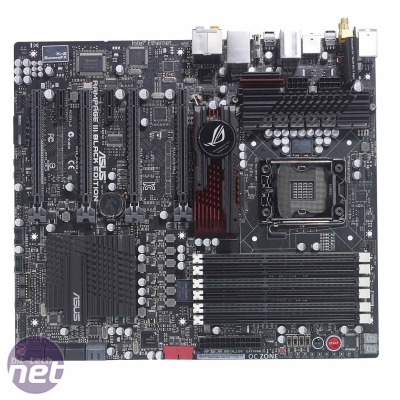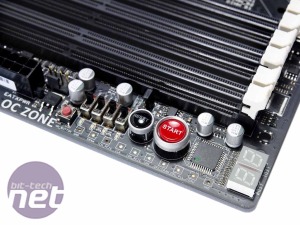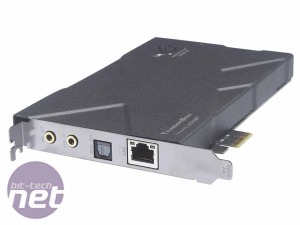
Asus Rampage III Black Edition Review
Manufacturer: AsusUK price (as reviewed): £359.98 (inc VAT)
US price (as reviewed): $589.99 (ex tax)
You could think of the think of the Rampage III Black Edition (R3B) as the Rampage Kitchen Sink Edition. That may sound a bit mean-spirited, but the R3B just has so much technology squeezed into its 305 x 269mm (W x D) PCB. The R3B is the pinnacle of Asus’ motherboard range; it sits above even the Rampage III Extreme in terms of gimmicks, gizmos, overclocking prowess and anything else the company’s fearsomely innovative design team can imagine.
Furthermore, the motherboard itself has 802.11n WiFi and Intel Gigabit LAN built in, plus an eight-channel Creative SupremeFX X-Fi 2 audio codec. This might support all the fancy EAX 5.0 game audio effects, but it does so in software and there’s no Crystallizer either.
Bluetooth 3.0 is provided, and there are four network controllers, two audio processors and more overclocking tools than you could possibly use – the lack of tea-making facilities seems almost stingy.
Plus there’s the new Thunderbolt add-in card, which incorporates a Killer NIC processor and an Asus Xonar two-channel sound chip. However, we’ve found Killer NICs don't improve online game performance much in these days of reliable high-speed broadband. Whether or not the Thunderbolt card is useful brings us onto the thorny issue of what exactly the R3B is for – or rather, whom it is for.
The Thunderbolt card has gamer tech written all over it, and yet the board has a plethora of extreme overclocking, LN2-friendly features. There is an OC Zone towards the top of the front edge of the board, which not only has an LN2 mode jumper (to remedy the cold-boot bug at sub-zero temperatures), but also eight voltage readout points.
There’s also a bank of switches to enable and disable the four 16x PCI-E slots individually, so that you can troubleshoot faults without having to remove cards – next to each switch is an LED to show whether or not the slot is active. Nearby, you’ll find a Go button to load a memory overclock profile automatically, as well as conveniently placed power and reset buttons.
Click to enlarge
Elsewhere you’ll find two 8-pin EPS12V power connectors for the CPU, a button to switch to another saved BIOS profile (LEDs nearby tell you which one you’re using) and a jumper to enable QPI loadline calibration. Plus, if you’re really struggling with your LN2 to the point where the board won’t even POST, there’s a Q Reset button to kill the power for a bit and ‘help the CPU recover from a frozen condition.'
To round off the list of crazy overclocking features on the board before we even delve into the BIOS, there’s the RoG Connect port on the rear I/O that lets you overclock the board remotely from a laptop (or from a smartphone via the Bluetooth link). This really isn’t a motherboard for typical PC gamers – it’s an overclocking leviathan.
Specifications
- Chipset Intel X58
- CPU support LGA1366 Core i7, Core i7 Extreme Edition
- Memory support 6 slots: max 24GB DDR3 (2,200MHz)
- Expansion slots Four 16x PCI-E slots (Two 16x or one 16x and two 8x, or four 8x), two 1x PCI-E slots
- Sound Creative SupremeFX X-Fi with 8-channel support. Asus Thunderbolt (Xonar) with 2-channel support
- Networking Asus Thunderbolt (Killer NPU) Ethernet, Intel Gigabit Ethernet, WiFi 802.11b/g/n, Bluetooth 3.0 + HS
- Overclocking CPU clock 100-500MHz; max voltages: CPU 2.3V, RAM 2.504V, IOH 2.1995V, ICH 2.00075V, QPI DRAM 2.5V, 2.015V, CPU PLL 2.05375V, ICH PCIE, 2.05375, QPI/PIE Tuning, CPU Differential Amplitude 700-1000mV, CPU and IOH Clock skew, Extreme Engine Digi+m QPI, IOH, DRAM frequency: 1x or 33x
- Ports 6x SATA 3Gbps, 2x SATA 6Gbps, 1x PS/2, 11x USB 2, 4x USB 3, 2x LAN, 6x surround audio outputs, 2x line in, 2x mic, 2x eSATA 6Gbps
- Dimensions (mm) 305 x 269 (ATX)

MSI MPG Velox 100R Chassis Review
October 14 2021 | 15:04











Want to comment? Please log in.